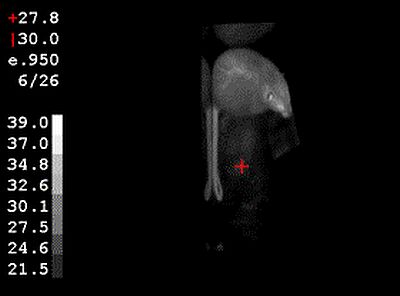
Automated infrared thermographic tracking as a non-invasive tool for measuring long-term temperature effects of social stress
B.B. Houx, B.M. Spruijt and J.M. Baars
Ethology & Animal Welfare, Utrecht University, Utrecht, The Netherlands
Non-invasive automated infrared thermography is a useful new tool for tracking immediate stress-induced skin and tail temperature changes (comparable to Stress Induced Hyperthermia) in free-moving animals. Previously, we have found indications that the latency and amplitude of these autonomously-mediated temperature responses differ between enriched- and standard-housed rats.
Here, we use a social-stress paradigm to test the hypothesis that the normal course of the skin-temperature response to a stressor is altered in rats with reduced wellbeing. The paradigm consists of a social defeat followed by social isolation. The combination of both is known to be a powerful stressor with many long- and short-term effects on behavior and physiology, for which reason it is often regarded as a model for human depression and for reduced animal welfare.
We compared defeated (n = 8) and control rats (n = 8) in several tests over time. The control rats differed in none of the behavioral variables considered, which was unexpected. In contrast, the defeated rats showed a more pronounced skin- and tail-temperature response to various stressors. For instance, four weeks after the defeat, the rats were placed in a novel cage. All rats responded with an immediate decrease in tail temperature, but the two groups differed significantly in the speed of subsequent increase to normal levels (mean ± se for defeated rats: 0.26 ± 0.03 °C/min; for controls: 0.37 ± 0.06 °C/min; Mann-Whitney U-test: U = 10, p < 0.05). In general, the tail temperature of the defeated rats stayed at a low level for longer periods. This effect was found on several occasions, from four weeks after the defeat onwards. See Figures 1 and 2.

Figure 1. A thermographic image of a rat.

Figure 2. Another image of the same rat, taken two minutes late, after a novel object.
These results are in line with other studies indicating that physiological measures are often more sensitive than behavioral measures. An interesting finding was that tail temperature increased sharply approximately 9 min after the stress-induced decrease. There are some indications that the onset of this increase is related to the intensity of the stressor, as perceived by the animal. These data show the potency of automated infrared thermography as a tool for detecting a physiological indicator of reduced welfare. The potential uses of this non-invasive method for monitoring welfare in other species will be discussed.
Paper presented at Measuring Behavior 2002 , 4th International Conference on Methods and Techniques in Behavioral Research, 27-30 August 2002, Amsterdam, The Netherlands